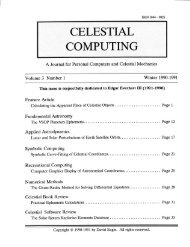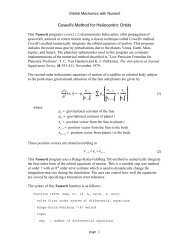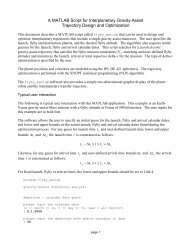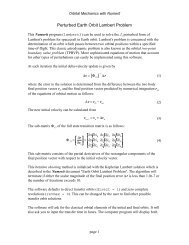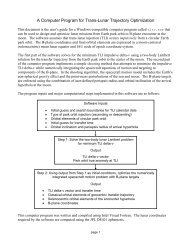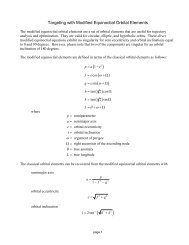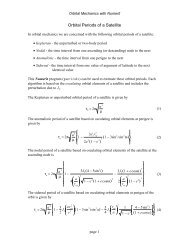The Circular Restricted Three-body Problem
The Circular Restricted Three-body Problem
The Circular Restricted Three-body Problem
- No tags were found...
Create successful ePaper yourself
Turn your PDF publications into a flip-book with our unique Google optimized e-Paper software.
Celestial Computing with NumeritNotice that each orbit is defined by an initial x-component of position, x 0, an initialy-component of velocity, y· 0, a value of Earth-Moon mass ratio µ , and an orbital periodor final time t f. <strong>The</strong> initial y-component of position and x-component of velocity for eachthese orbits is equal to zero. <strong>The</strong> software will draw the location of the libration point onthe graphics display.If you would like to experiment with your own initial conditions, select option 4. <strong>The</strong>program will then prompt you for the initial x and y components of the orbit's position andvelocity vector, and the value of to use in the simulation. <strong>The</strong> software will also ask for aninitial and final time to run the simulation, and an integration step size. <strong>The</strong> value 0.01 is agood number for step size.Here is a short list of initial conditions for several other periodic orbits which you maywant to display with this program.(1) Retrograde periodic orbit about m 1x 0= −2.499999883y· 0 = 2.100046263µ = 0.012155092t f= 11.99941766(2) Direct periodic orbit about m 1x 0= 0.952281734y· 0 = −0.957747254µ = 0.012155092t f= 6.450768946(3) Direct periodic orbit about m 1and m 2x 0= 3.147603117y· 0 = −3.07676285µ = 0.012155092t f= 12.567475674(4) Direct periodic orbit about m 2x 0= 1.399999991y· 0 = −0.9298385561µ = 0.012155092t f= 13.775148738page 3




